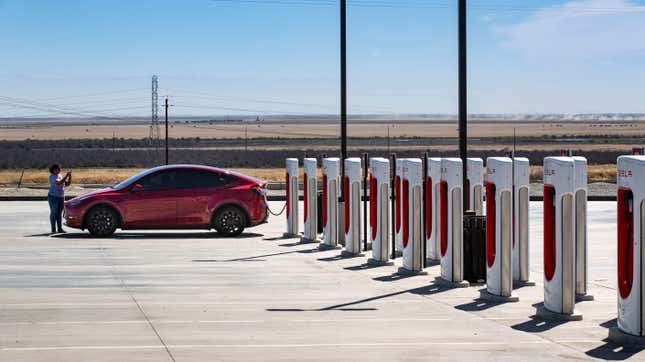
The energy efficiency of electric vehicles is widely touted by experts as a vital step to mitigate climate change. However, EVs aren’t well-equipped to endure the hellscape environment they are projected to avert. The consequences of cold-weather EV ownership on battery function are well-known, but high temperatures have a similar impact. Heatmap took a peek under the hood to explore how extreme heat can cut the range on an electric vehicle:
As long as the afternoon high temperature doesn’t get too high, an EV’s range loss is manageable. With an outside temp of 80 degrees Fahrenheit, they found the car loses only 2.8% of its range to keep the cabin at 70 degrees. Even at 90 degrees, the loss reaches just 5%. That amounts to just 10 miles lost from a 200-mile EV. You might not even notice it — it’s probably not that far off from what’s lost by driving 80 miles per hour down the freeway instead of the posted speed limit of 65.
When it’s dangerously hot out, though, the story changes quickly. At 95 degrees outside, the average EV loses 15% of its potential range. At 100 degrees outside, the car suffers a staggering 31% range loss to maintain 70 degrees inside the car. The bigger the difference between the outside temperature and the desired inside temperature, the more of your juice is lost to climate control rather than moving the vehicle. This is why range loss is typically worse in winter — a 10-degree day in Duluth means you’re 60 degrees away from the desired 70 Fahrenheit, while a 110-degree day in Phoenix is “only” 40 degrees from the target.
While the air conditioning system contributes a decent amount of the energy drain, high heat causes long-term damage to battery components. Three simple yet unintuitive steps can minimize battery degradation: Don’t charge the battery to 100 percent, don’t store the battery at 100 percent, and don’t let it drain all the way to zero. It would be so much simpler if the environment weren’t so hostile to humanity’s existence.
Previous studies have shown how much winter weather impacts electric vehicles. Particular models, like Volkswagen ID4 and Ford Mustang Mach-E, lost 30 percent of the battery’s range. The only upside about the freezing cold compared to the heat is that the battery providing power also generates heat just under the floor. Temperature management will always be a vital aspect of EV development.







